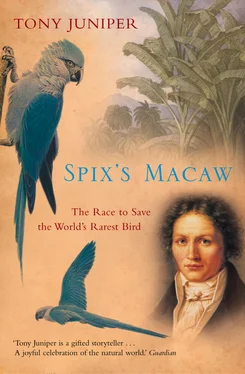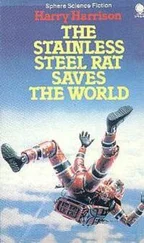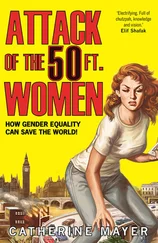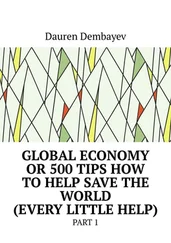They fluttered to an opening in the caraiba’s dense canopy to gain a better view of the creek. Finding no line of sight to the source of the sound they cautiously flew towards it. The noise was coming from some distance away on a bend in the creek. The three birds approached. As they drew nearer they could see on the ground a struggling parrot. It appeared unable to move from its place on the creek bed even though it was violently writhing. The single blue macaw approached while the pair remained at a distance. His natural caution overtaken, the parrot descended to a low perch closer to the bird struggling on the ground.
As he settled, two men burst forth and ran towards him. They crashed over dry sticks and leaves that lay on the sandy bed of the creek. Terrified, the macaw took to his wings, but he couldn’t fly. The spot where he had perched was covered in bird lime, a glue substance used to trap birds. It had trapped him.
Seconds later he was inside a nylon net. The men snapped the branch he was involuntarily gripping and wound the mesh around it, trapping him. The bird’s sharp hooked beak tore at the net but it wouldn’t give. Seconds later the blue macaw, still inside the net and glued to the perch, was caged in a wire mesh-fronted crate. He lay panting on the floor covered in glue, tangled in the net where he had no choice but to grip the branch to which he was stuck. He called out, but there was no answer; his companions were already far away. It was the end of April 1987.
The trapper and his assistant sat on the huge fallen trunk of a dead caraiba tree and smiled. Dressed in modern city clothes they had arrived in a four-wheel-drive vehicle, a rare sight in this poor area where local transport was more often by horse or mule. They smoked cigarettes and talked for a while. Then they rose to their feet and approached the crate. One of the men put on thick leather gloves while his assistant opened the door. The gloved man picked up the bird, still inside the net, while his companion cut away the nylon with a penknife. The parrot’s feet were prised from the broken branch and a scrap of cloth cleaned some of the glue from its feet. The blue bird, paralysed with fear, was put back into the crate and door once more wired fast.
The gloved man stood back and regarded his prize with obvious pleasure. The sight of the caged blue parrot took his thoughts back to when he was a boy of eleven. A neighbour had asked him to look after some young parrots he was rearing. Soon after the neighbour had had to leave the area and told the boy he could keep the birds. When they were ready for sale he put them in a cart and took them round the streets in his town and found that they sold very well. The boy got some more parrots and as time went by became more knowledgeable and serious about his surprisingly lucrative vocation. By the time he was seventeen he had bought himself a second-hand car; quite an achievement in this part of the world. He marvelled at his good fortune – the birds had helped him escape the grinding poverty suffered by the poor rural people in the caatinga. He was lucky enough to have a small house in town that he shared with his wife and three young children. He only came to the country for more parrots.
As the years went by, his reputation as a parrot dealer grew, first in Brazil and then internationally. If you wanted to buy a Brazilian macaw, he was your man. He had first caught some of the special blue caatinga macaws in the early 1980s when he took a couple of babies from their nest. He traded the azure bundles of fluff for a car; this time it was brand new. Since then he had not looked back. It was easy money; better still it was big money. Capturing another of these special blue parrots was a real achievement. The heavily built trapper had notched up yet another of the special blue prizes.
All kinds of blue macaw were in big demand and the trapper had caught the parrot to fulfil an order placed by a foreign bird collector. The obsession of the men who would own a blue macaw, if they could get one, was such that any bird caught could easily be sold. This one was no exception; it would now travel via a series of dealers working as part of the criminal underworld of the international illegal bird trade.
Unlike some common parrots, this one was not destined for a run-of-the-mill pet keeper. A member of the world’s bird-collecting elite would have this one. There were plenty of people who would happily part with a fortune for such a parrot and he would be sold to one of the real connoisseurs, a collector who would fully appreciate the rarity and value of such a trophy. All kinds of blue macaw fetched excellent prices but these caatinga macaws were different. This bird was like a Rembrandt or a Picasso, one of the finer things that only the really wealthy could afford. Unlike a painting by a great master, however, this bird was a temporary treasure only. One day he would die, his value would be gone and another would be demanded to replace him. No matter how many were caught, there was relentless demand for more.
As the long hot dry season passed, the traumatic memory of the trapping faded, but the surviving pair of blue parrots remained very nervous. Any people near the creek sent them into fast flight. The normal activities of the sparse local population, the odd ranch hand passing by on horseback, or people from one of the isolated houses nearby collecting leafy branches for their goats and sheep to eat, created panic. The birds took no chances even with these casual visitors. They would take flight up the creek until they had travelled what they regarded as a safe distance.
The pair of blue parrots nested in a particular hole that had been used by their kind for generations. High up in one of the big trees, it had been formed by the fall of a huge branch some five decades before. Almost every year since then a pair of the blue parrots had laid their eggs in that same favourite refuge. The hollow was dry and the nesting area was some distance down into the tree from the exit to the outside world. It was just right, the ideal place to rear babies. But such a location was valuable and the blue macaws didn’t have an exclusive claim.
Most of the best tree holes in the creek were accounted for in some way. The woodpeckers, black vultures, the other parrots, like the maracanas, and even snakes liked to use tree cavities as well. Lately, bees introduced from Africa had also moved into the creek. Swarms of these insects were especially dangerous when they wanted to take possession of a tree hole. They had killed parrots, stung them to death, so as to take over a prime site.
With the arrival of the wet season, the birds spent more time around the nest hollow, both to defend it from unwanted squatters and to prepare themselves for breeding. A couple of weeks later, in mid-December, the female bird stayed inside during the day. She had laid three white eggs; they rested in the bottom of the hollow where she would now devote most of her time to maintaining the correct temperature and humidity for the tiny embryos to grow and then hatch.
One night, when the two parrots were asleep with their eggs in the nest hole, the drone of a vehicle was heard once more in the creek. The birds would not venture out; owls were a real danger after dark. They sat tight even when they heard scraping sounds on the outside of the tree. They heard whispering human voices by the hole and huddled silently. But when they felt a presence come inside, they fled. The female made her move for the entrance first. In the darkness all she could see was the gloomy disc of the pre-dawn sky. She made for it, climbing the inside of the tree trunk, a familiar enough task in the day but in the near-total darkness unnatural and frightening. As she made her exit, and spread her wings for flight, she became constrained. She was in a net. Something powerful, hard and unyielding grasped her body. As she struggled to free herself from her captor, her mate struggled past and fluttered free of the hollow. He found his wings and took off down the creek into the darkness as fast as he could.
Читать дальше












